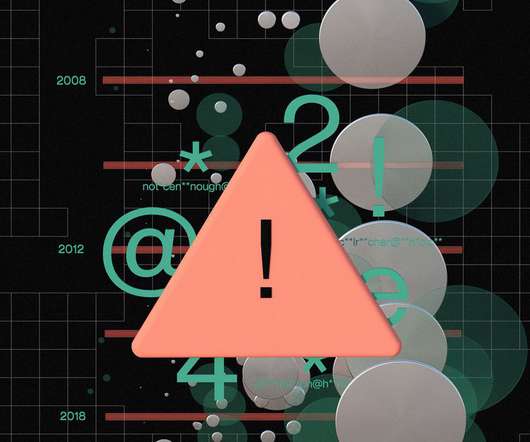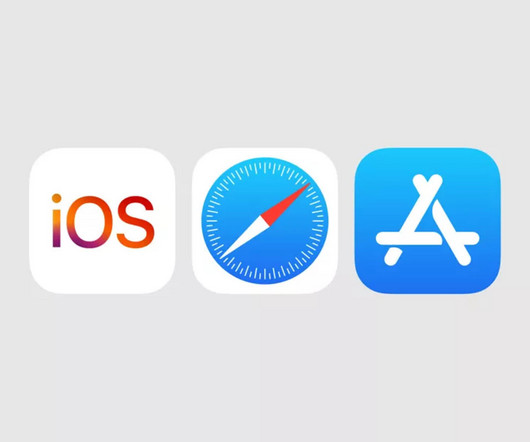Malware Extension in PyPI Downloaded Over 2,300 Times
IT Toolbox
JANUARY 3, 2023
The post Malware Extension in PyPI Downloaded Over 2,300 Times appeared first on. But should you lose sleep over it?
This site uses cookies to improve your experience. By viewing our content, you are accepting the use of cookies. To help us insure we adhere to various privacy regulations, please select your country/region of residence. If you do not select a country we will assume you are from the United States. View our privacy policy and terms of use.

IT Toolbox
JANUARY 3, 2023
The post Malware Extension in PyPI Downloaded Over 2,300 Times appeared first on. But should you lose sleep over it?

IT Toolbox
DECEMBER 15, 2023
Since May 2023, the malicious packages have been downloaded over 10,000 times. The post Windows and Linux Systems at Risk to PyPI Repository Malware Packages appeared first on Spiceworks.
This site is protected by reCAPTCHA and the Google Privacy Policy and Terms of Service apply.

Tech Republic Security
NOVEMBER 22, 2023
Atomic Stealer malware advertises itself through ClearFake browser updates disguised as Google's Chrome and Apple’s Safari.

IT Toolbox
APRIL 17, 2023
A malware named ‘Goldoson’ has been found in 60 Playstore apps that have a combined 100 million downloads. The post Android Malware Infects Legitimate Google Play Apps, Millions Impacted appeared first on Spiceworks.

Tech Republic Security
JANUARY 11, 2022
Google took over the top spot for malicious downloads from Microsoft OneDrive as attackers created free accounts, uploaded malware and shared documents with unsuspecting users, says Netskope.

Tech Republic Security
JANUARY 18, 2023
The volume of cloud-based malware tripled in 2022 over the prior year, says Netskope, with 30% of the malicious downloads coming from Microsoft OneDrive. The post Rise of cloud-delivered malware poses key security challenges appeared first on TechRepublic.

TechSpot
SEPTEMBER 16, 2024
The malware embeds itself within the system storage area, allowing it to download and install third-party software remotely when commanded by an attacker. The origin of the malware is currently unknown, but researchers suspect it may result from a prior compromise that exploits operating system vulnerabilities to gain root privileges.

TechSpot
AUGUST 31, 2022
This week, IT security group Checkpoint Research (CRP) published a report on its discovery of a crypto mining malware campaign hiding behind legitimate-looking apps, including Google Translate. The programs download malware while performing their advertised functions to gain users' trust.

CTOvision
DECEMBER 30, 2020
A new strand of malware uses Word files with macros to download a PowerShell script from GitHub. This PowerShell script further downloads a legitimate image file from image hosting service Imgur […].

TechSpot
AUGUST 1, 2024
The Mandrake malware family was initially discovered by Bitdefender in 2020. The Romanian cybersecurity company detected the threat in two major infection waves, first in fake apps available for download on Google Play in 2016-2017 and again in 2018-2020. Mandrake's most notable feature was its ability to fly under Google's.

TechSpot
APRIL 17, 2023
However, the developers who used Goldoson didn't realize that they were adding a malicious malware component to their programs. McAfee's mobile research team discovered a third-party software library it named Goldoson, which collects sensitive information and performs ad fraud. Read Entire Article

Tech Republic
NOVEMBER 8, 2023
A new malware is bypassing an Android 13 security measure that restricts permissions to apps downloaded out of the legitimate Google Play Store.

SecureWorld News
APRIL 11, 2024
The Raspberry Robin malware, a heavily obfuscated Windows worm first identified in late 2021, has become one of the most prevalent threats facing enterprises today. Jason Soroko, Senior Vice President of Product at Sectigo, discussed the sophistication of this malware.

TechSpot
DECEMBER 17, 2021
Cybersecurity researchers at Pradeo regularly update an article identifying mobile applications available on the Google Play Store infected with Joker malware. The latest entry, which came yesterday, highlighted an app called Color Message.

TechSpot
MAY 12, 2023
Last month, we learned that malware had been discovered in 60 Android apps with over 100 million downloads – another black eye for the mobile operating system that has an estimated three billion active users worldwide. Malicious developers regularly exploit various loopholes in Google's app vetting process to create apps.

SecureWorld News
FEBRUARY 15, 2024
A sophisticated form of mobile malware dubbed "GoldPickaxe" has been uncovered, which collects facial recognition data to produce deepfake videos, enabling hackers to bypass biometric authentication protections on banking apps. The malware has been active since 2023, specifically targeting victims in Vietnam and Thailand.

TechSpot
MARCH 22, 2022
Researchers at French mobile security company Pradeo revealed that the app, Craftsart Cartoon Photo Tools, contained a version of an Android trojan malware called Facestealer.

TechSpot
OCTOBER 21, 2021
There is no official Squid Games app—not counting Netflix, of course—yet ESET’s Android malware researcher Lukas Stefanko tweeted that there are over 200 applications related to the series listed on the Play Store, and at least one of them was yet another piece of malicious software that slipped past Google’s.

CTOvision
JULY 29, 2014
Three Questions on Automated Malware Removal with Bob Gourley, Cognitio Corp and CTOVision. While there’s still an emphasis – and related spending – on malware detection, most incident response teams are actually overwhelmed by vast number of security alerts they receive. Another day, another data breach. Bob Gourley: That’s simple.

Tech Republic Security
APRIL 22, 2024
Threats from malware, cryptographic infections and compromised networks have never been greater. Headlines regularly attest to such widespread problems, from infection-felled organizations to dangerous vulnerabilities in popular tools.

CTOvision
JUNE 21, 2014
The video at this link and embedded below provides an overview of conclusions from CTOvision research into ways to automate the removal of cyber threats (including malware) from your enterprise. Additional context into this topic is available in our research report downloadable here: . This paper.

TechSpot
JUNE 23, 2021
Once downloaded, criminals use the backdoor to send follow-up malware, such as ransomware, scan the environment, and exploit other vulnerable hosts on the network. A post by Palo Alto Networks' Brad Duncan (via ZDNet) explains that BazarLoader provides backdoor access to an infected Windows host.

TechSpot
APRIL 7, 2022
Check Point security researchers said the six apps had been downloaded over 15,000 times before Google removed them from its store following the cybersecurity firm's disclosure. While users thought they were downloading mobile antivirus apps, they were actually installing the Sharkbot Android stealer, ironically.

The Verge
AUGUST 31, 2020
Apple accidentally approved common malware disguised as an update for Adobe Flash Player to run on macOS, according to a new report. According to security researcher Patrick Wardle, Apple approved an app that contained code used by a well-known malware called Shlayer. Illustration by Alex Castro / The Verge.

TechSpot
OCTOBER 19, 2020
As per Bleeping Computer, the malware is delivered through spam emails containing either malicious Word or Excel documents or download links. When opened, the attachments prompt users to ‘Enable Content’ to allow macros to run, which install the Emotet trojan.

TechSpot
APRIL 1, 2021
It surreptitiously installed a dropper on a device, which allowed other types of malware to be downloaded onto a computer. As reported by Vice, security researchers at Activision found that a Warzone cheat advertised on popular cheating forums contained more than met the eye.

SecureWorld News
AUGUST 8, 2022
Cybersecurity and Infrastructure Security Agency (CISA) and the Australian Cyber Security Centre (ACSC) released a joint Cybersecurity Advisory (CSA) providing details on the top malware strains of 2021. The top malware strains in 2021 included remote access Trojans (RATs), banking Trojans, information stealers, and ransomware.

IT Toolbox
NOVEMBER 16, 2022
Threat actors are impersonating 400 brands using 42,000 fake websites to lure unwitting users into generating traffic and downloading malware. The post Chinese Threat Actors Used 42,000 Fake Domains To Run a Giant Malvertising Campaign appeared first on.

SecureWorld News
MAY 1, 2023
Google has obtained a temporary court order to disrupt the distribution of CryptBot, a Windows-based information-stealing malware that has infected more than 670,000 computers in 2022. The harvested data is then sold to other attackers for use in data breach campaigns.

SecureWorld News
OCTOBER 20, 2022
Google Play has removed 16 apps from its app store after the McAfee Mobile Research Team alerted the company to Clicker malware associated with the apps, affecting 20 million people who installed the apps. Like so many mobile malware schemes, the apps profess to be helpful to users, providing a handy tool or time-saving utility.

CTOvision
JUNE 10, 2014
We believe this is the only way to reduce the impact of malware and breaches in a cost effective way. Download “Automating Removal Of Advanced Threats” Automating-Removal-of-Malware.pdf – Downloaded 9 times – 918 kB. This approach has been proven to significantly improve enterprise defenses. This paper.

Dataconomy
OCTOBER 22, 2024
Virus or malware: It may be downloaded from website online or bundled with the software you are using that will maliciously delete your files. Download and install MyRecover. Formatting: Sometimes your disk behave abnormally but you don’t notice until your system ask you to format disk before using it.

Dataconomy
OCTOBER 2, 2023
According to various sources, the chatbot has been pushing malware ads under search queries, which is a huge cyber threat to people who trust and use the tool. They requested download links for Advanced IP Scanner, a well-known network management application, via Bing Chat.

The Verge
MARCH 31, 2021
Hackers have been hiding malware in cheating software for Call of Duty: Warzone and have been trying to spread it to “cheating cheaters,” as a report from Activision calls them ( via Vice ). After players run it, the malware can then go on to infect the computer with whatever payload is chosen by the hacker.

Gizmodo
MAY 22, 2020
While many parts of America are preparing to slowly reopen after months of lockdown, coronavirus-related scams and malware campaigns show no signs of abating. The Microsoft Security Intelligence Team recently disclosed details on two massive coronavirus phishing campaigns duping users into downloading and opening… Read more.

The Verge
OCTOBER 6, 2021
If you think your PC is infected with some kind of malware or you just want to do a scan as part of a digital cleanup, Windows has a built-in security tool that can help you on your way — no third-party software to install or pay for. After you’ve got it open, here’s some of what you can do: Run a malware scan on Windows 11.

TechSpot
AUGUST 4, 2024
Apple employs comprehensive security measures to protect its apps from malware and tampering. Users can only download applications for iOS and iPadOS from the App Store, where they first undergo a thorough review process. This comprehensive undertaking combines automated systems with human reviewers to maintain high-security standards.

CTOvision
JULY 23, 2014
We believe this is the only way to reduce the impact of malware and breaches in a cost effective way. Download “Automating Removal Of Advanced Threats” Automating-Removal-of-Malware.pdf – Downloaded 468 times – 918 kB. This approach has been proven to significantly improve enterprise defenses. This paper.

Gizmodo
APRIL 9, 2021
Cybercriminals have been pushing Facebook users to download a Clubhouse app “for PC,” something that doesn’t exist. The app is actually a trojan designed to inject malware into your computer. The popular new invite-only chat app is only available on iPhone but worldwide interest in the platform has risen and users are… Read more.

Network World
NOVEMBER 15, 2018
Unfortunately, that makes you a high-risk candidate for a cyber attack at some point along the way, be it through malware , phishing , or hacking. Malwarebytes is a free program built to help you avoid the above scenarios altogether — and it makes traditional antivirus look old, tired, and played out (seriously it’s free, download it here ).

Dataconomy
FEBRUARY 12, 2024
Malware continues to plague organizations and individuals alike and one of the more insidious strains in recent times is the Raspberry Robin malware. Malware – malicious software crafted with harmful intent – acts as their weapon of choice.

The Verge
MAY 19, 2021
And as I say, today, we have a level of malware on the Mac that we don’t find acceptable and is much worse than iOS.”. And that’s despite the fact that Mac users inherently download less software and are subject to a way less economically motivated attacker base.

CIO Business Intelligence
NOVEMBER 1, 2024
Each quarter HP’s security experts highlight notable malware campaigns, trends and techniques identified by HP Wolf Security. Living-off-the-land techniques Many malware campaigns relied on living-off-the-land (LOTL) techniques to help attackers remain undetected by blending in with legitimate system admin activity [7].
Expert insights. Personalized for you.
We have resent the email to
Are you sure you want to cancel your subscriptions?


Let's personalize your content